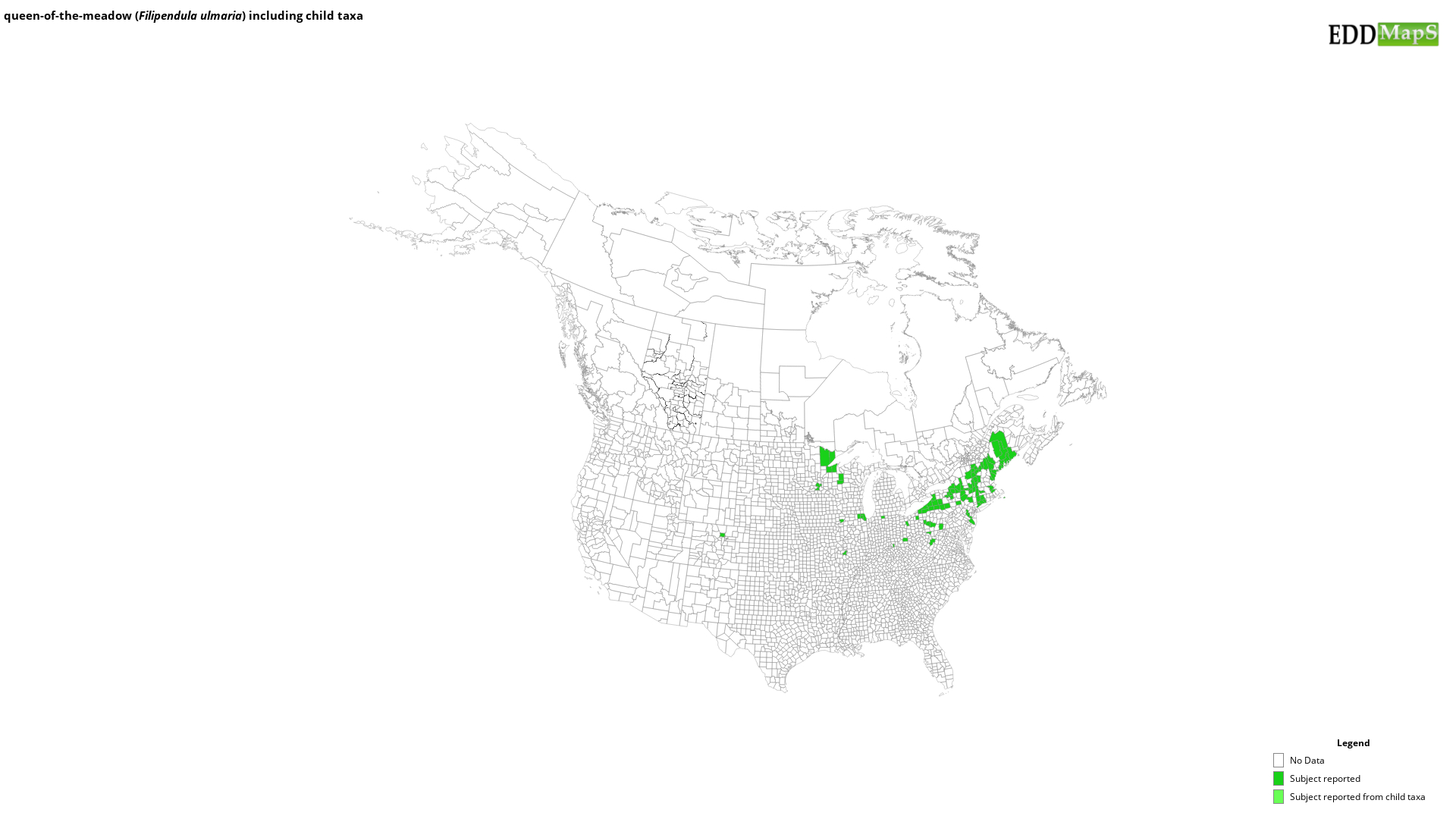queen-of-the-meadow
(Filipendula ulmaria)
This species is Introduced in the United States
ORIGIN: temperate Asia
GROWTH TRAITS: Upright, herbaceous perennial typically growing 3-5' (0.9-1.5 m) tall and half as wide from a rhizomatous root system. Stems are rigid and often tinged in red. Leaves are alternate and divided into 3-5 pairs of opposite leaflets with one terminal leaflet. Terminal leaflets are deeply lobed into 3 segments, each segment resembling a side leaflet. Side leaflets are ovate with a pointed tip and have distinct venation and doubly-toothed margins. Side leaflets are up to 3" (7.5 cm) long with lighter-colored and hairy undersides. At the base of the leaf stalk is a pair of leafy appendages that appear to clasp the stem. Very fragrant flowers bloom in early to mid-summer. The tiny flowers are up to 0.3" (08 mm) in diameter, have 5 white petals, numerous long stamens, and appear in large clusters at stem tips or upper leaf axils. The fruits are intertwined, twisted achenes up to 0.25" (6 mm) long that are green initially, but mature to brown.
REPRODUCTION: Spreads by seed and rhizomes. Seed longevity is unknown.
HABITAT: Prefers damp or wet sites where the water levels fluctuate but where the soil is not continuously water-logged. In North America, this includes streams and irrigation ditches, moist meadows, roadsides where water gathers, and wetlands.
LOOK-ALIKES: Several unrelated species resemble queen of the meadow with their compound, toothed leaves and large clusters of tiny, white, 5-petal flowers, such as the native American elderberry (Sambucus nigra ssp. canadensis). American elderberry differs by growing as a shrub or small tree and having black berry-like fruits. Several related species of Spiraea also closely resemble queen of the meadow, however, species in that genus grow as shrubs. The more closely related dropwort (Filipendula vulgaris) and queen of the prairie (F. rubra) have a similar overall shape, but neither has twisted fruits. The leaves of dropwort are more divided as to appear fern-like, and the flowers of queen of the prairie are pink.
CITATIONS:
Rawlins, K.A., R.L. Winston, C.T. Bargeron, D.J. Moorhead, and R. Carroll. 2018. New Invaders of the Northeast and Northcentral United States. USDA Forest Service, Forest Health Assessment and Applied Sciences Team, Morgantown, West Virginia. FHTET-2017-04. Retrieved from https://bugwoodcloud.org/resource/pdf/FHTET-2017-04_New%20Invaders_NE.pdf
GROWTH TRAITS: Upright, herbaceous perennial typically growing 3-5' (0.9-1.5 m) tall and half as wide from a rhizomatous root system. Stems are rigid and often tinged in red. Leaves are alternate and divided into 3-5 pairs of opposite leaflets with one terminal leaflet. Terminal leaflets are deeply lobed into 3 segments, each segment resembling a side leaflet. Side leaflets are ovate with a pointed tip and have distinct venation and doubly-toothed margins. Side leaflets are up to 3" (7.5 cm) long with lighter-colored and hairy undersides. At the base of the leaf stalk is a pair of leafy appendages that appear to clasp the stem. Very fragrant flowers bloom in early to mid-summer. The tiny flowers are up to 0.3" (08 mm) in diameter, have 5 white petals, numerous long stamens, and appear in large clusters at stem tips or upper leaf axils. The fruits are intertwined, twisted achenes up to 0.25" (6 mm) long that are green initially, but mature to brown.
REPRODUCTION: Spreads by seed and rhizomes. Seed longevity is unknown.
HABITAT: Prefers damp or wet sites where the water levels fluctuate but where the soil is not continuously water-logged. In North America, this includes streams and irrigation ditches, moist meadows, roadsides where water gathers, and wetlands.
LOOK-ALIKES: Several unrelated species resemble queen of the meadow with their compound, toothed leaves and large clusters of tiny, white, 5-petal flowers, such as the native American elderberry (Sambucus nigra ssp. canadensis). American elderberry differs by growing as a shrub or small tree and having black berry-like fruits. Several related species of Spiraea also closely resemble queen of the meadow, however, species in that genus grow as shrubs. The more closely related dropwort (Filipendula vulgaris) and queen of the prairie (F. rubra) have a similar overall shape, but neither has twisted fruits. The leaves of dropwort are more divided as to appear fern-like, and the flowers of queen of the prairie are pink.
CITATIONS:
Rawlins, K.A., R.L. Winston, C.T. Bargeron, D.J. Moorhead, and R. Carroll. 2018. New Invaders of the Northeast and Northcentral United States. USDA Forest Service, Forest Health Assessment and Applied Sciences Team, Morgantown, West Virginia. FHTET-2017-04. Retrieved from https://bugwoodcloud.org/resource/pdf/FHTET-2017-04_New%20Invaders_NE.pdf
Maps
EDDMapS Distribution - This map is incomplete and is based only on current site and county level reports made by experts, herbaria, and literature. For more information, visit www.eddmaps.org
State Lists - This map identifies those states that have this species on their invasive species list or law.
Invasive Listing Sources
Taxonomic Rank
| Domain: Eukarya |
| Kingdom: Plantae |
| Phylum: Magnoliophyta |
| Class: Magnoliopsida |
| Superorder: Rosanae |
| Order: Rosales |
| Family: Rosaceae |
| Genus: Filipendula |
| Filipendula ulmaria |
Synonyms and Other Names
Other Common Names:
queen of the meadow
Related Scientific Names:
Filipendula ulmaria (duplicate) (L.) Maxim. (Misspelling)
Filipendula ulmaris (L.) Maxim. (Synonym)
References
Common Name Reference: Weed Science Society of America Common Names List
Scientific Name Reference: USDA, NRCS. 2010. The PLANTS Database. National Plant Data Center, Baton Rouge, LA, USA.


